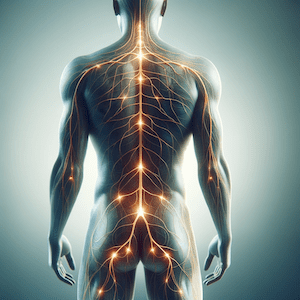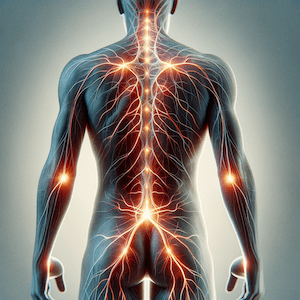Nerve Pain
Article by John Miller


Nerve Pain
Understanding and Managing Your Symptoms
Introduction to Nerve Pain
Nerve pain, clinically known as neuropathic pain, is a complex and often debilitating condition that stems from damaged or dysfunctional nerves. This type of pain differs significantly from the typical nociceptive pain, commonly associated with physical injuries.
Nerve pain can manifest in various ways, including as a burning, stabbing, or shooting sensation, or even resembling an electric shock. Understanding nerve pain is crucial for effective management and treatment.

What Does Nerve Pain Feel Like?
People experiencing nerve pain often report a range of symptoms:
- Burning sensation
- Stabbing or shooting pain
- Aching or throbbing
- Sensations similar to an electric shock
These symptoms are indicative of an underlying issue with the nerves themselves, where they send incorrect pain messages to the brain.
What is the Most Common Nerve Pain?
Several conditions can lead to nerve pain:
- Pinched nerves
- Shingles (post-herpetic neuralgia)
- Trigeminal neuralgia
- Diabetic neuropathy
- Phantom limb pain post-amputation
- Cancer-related nerve pain
- Multiple sclerosis
- Side effects of chemotherapy
- HIV infection
- Alcoholism-induced nerve damage
How Do I Know if My Pain is Nerve Pain?
It’s important to differentiate between nerve pain and nociceptive pain. While nerve pain arises from nerve damage or dysfunction, nociceptive pain results from tissue damage. In some cases, individuals may experience both types concurrently.
What Medicine is Good for Nerve Pain?
Traditional painkillers such as paracetamol and anti-inflammatories often have limited effectiveness in treating nerve pain. Instead, medications like antidepressants or anti-epileptic drugs are used. These treatments aim to modify the nerve signals and alleviate pain. It’s always recommended to consult with a healthcare professional for tailored advice and treatment plans.
How Do You Make Nerve Pain Go Away?
Recent research has led to new approaches in nerve pain management. For instance, advances in understanding the molecular pathways involved in nerve pain have opened up possibilities for targeted therapies.
Additionally, non-pharmacological approaches like physiotherapy, acupuncture, tens machines and mindfulness techniques are gaining attention for their role in managing nerve pain.
Pain may also be changed with interventional procedures such as radiofrequency nerve ablation.
What to Do?
If you’re experiencing symptoms of nerve pain, it’s crucial to seek professional advice from a physiotherapist or doctor. A physiotherapist can provide a comprehensive assessment, recommend appropriate treatments, and guide you through pain management strategies. They can also advise on lifestyle changes and exercises that may alleviate symptoms. Your doctor may prescribe appropriate neurogenic or other medications.
Conclusion
Nerve pain, while challenging, can be managed effectively with the right approach. Understanding its causes, symptoms, and available treatments is the first step towards better managing this condition. Remember, seeking professional advice is key to developing a personalised treatment plan that addresses your specific needs.
Related Articles
- Pinched Nerve: Discusses symptoms, causes, and treatment options for a pinched nerve, emphasising the importance of early physiotherapy intervention.
- Sciatica Treatment & Management Strategies: Provides strategies for managing sciatica, including physiotherapy and lifestyle adjustments.
- Neurodynamics: Explores the concept of neurodynamics in physiotherapy, offering insights into treatment strategies for nerve-related issues.
- Effective Pain Relief With TENS Machine: Discusses how TENS machines can be used for pain management, including nerve pain relief.
- Carpal Tunnel Syndrome: Effective Physio Treatments: Details physiotherapy treatments for Carpal Tunnel Syndrome, focusing on relieving wrist and hand pain.
- Tarsal Tunnel Syndrome: Professional Advice: Offers advice on managing tarsal tunnel syndrome, including physiotherapy approaches.
- Piriformis Syndrome: Understanding & Physio Treatment Tips: Provides an overview of Piriformis Syndrome and physiotherapy treatment tips for relieving sciatic nerve compression.
- Bulging Disc: Symptoms, Causes, Treatments, Physio: Explains the symptoms and physiotherapy treatments for a bulging disc, a common cause of nerve pain.
Article by John Miller
What is Pain?
Introduction
Pain acts as a crucial alert system in your body, signalling when something is amiss. As physiotherapists, we understand pain not just as a symptom, but as a complex experience influenced by various physiological factors. This article, written from a physiotherapist's perspective, aims to demystify pain and offer insights into its management.


Understanding Pain Signal Transmission
The journey of a pain signal begins at the site of injury or discomfort. Here, receptor nerve cells, including nociceptors, detect harmful stimuli. These receptors are sensitive to various types of damage, such as thermal (heat), mechanical (pressure or impact), and chemical changes.
Once stimulated, these receptors transmit signals via nerve fibres to the spinal cord and brain. The types of nerve fibres involved are crucial in determining the nature of the pain:
- A-beta fibres: These large, myelinated fibres rapidly transmit sharp, well-localised pain.
- A-delta fibres: Smaller but still myelinated, they convey acute pain.
- C fibres: These small, unmyelinated fibres are responsible for dull, throbbing, and chronic pain sensations.
Nociceptors and Their Role in Pain
Nociceptors are specialised nerve cells that play a key role in pain perception. They are adept at picking up potential damage and efficiently communicating this information to the brain. The brain then interprets these signals, leading to the experience of pain.
Chronic Pain: Understanding the Long-term Impact
Chronic pain, lasting beyond the usual course of acute injury or illness, poses a significant challenge. It often involves complex interactions between physical and psychological factors. Recent research highlights the role of the brain in maintaining chronic pain, even in the absence of an identifiable physical cause.
Related article: Chronic Pain
Myelin Sheath: Speeding Up Pain Signals
The presence of a myelin sheath around a nerve fibre is crucial in determining the speed of pain signal transmission. Myelinated fibres (A-beta and A-delta) allow for faster communication compared to unmyelinated C fibres. This difference in speed can influence the type of pain experienced.
Physiotherapy Techniques for Pain Relief
Physiotherapists employ various methods to manage pain:
- Manual therapy: Techniques such as massage and joint mobilisation can provide immediate pain relief.
- Exercise therapy: Tailored exercises help in managing chronic pain by improving muscle strength and flexibility.
- Pain Education: Understanding the biological, psychological, and social aspects of pain can help individuals manage their pain more effectively.
- Cognitive Behavioural Therapy (CBT) is a psychological intervention that has proven effective in managing chronic pain. It's based on the concept that our thoughts, feelings, and behaviors are interconnected, and changing negative thought patterns can lead to changes in feelings and behaviors.
What Causes Post-Exercise Muscular Pain?
Muscle soreness after exercise, often felt as a dull, aching pain, is commonly due to microscopic damage to muscle fibres and the surrounding tissues. This is a normal response and part of the muscle strengthening process.
The Brain's Role in Pain Perception
The brain plays a central role in interpreting pain signals. It integrates information from the body and can modulate the pain experience based on various factors, including emotional and psychological states.
Conclusion
Pain, a complex and subjective experience, involves intricate neurophysiological processes. Understanding these processes is crucial for effective pain management. Physiotherapy offers a range of techniques to alleviate pain, tailored to individual needs.
What to Do? Seeking Professional Advice
If you are experiencing persistent or unexplained pain, consulting a physiotherapist is a vital step. They can provide a comprehensive assessment, guidance, and a tailored treatment plan to manage your pain effectively.
For more detailed information and resources, visit our Pain Management section, a trusted source for physiotherapy insights and treatments.













































